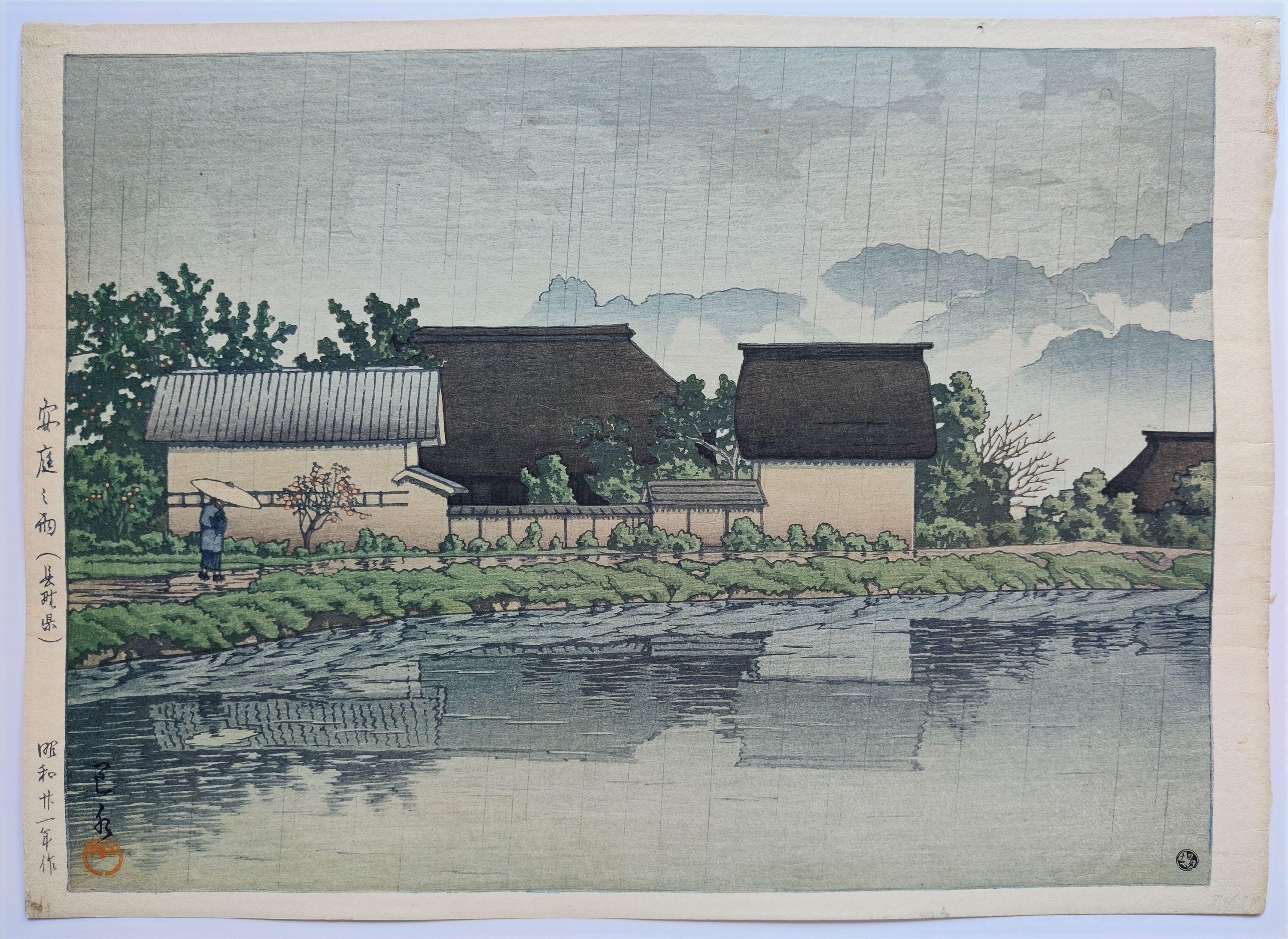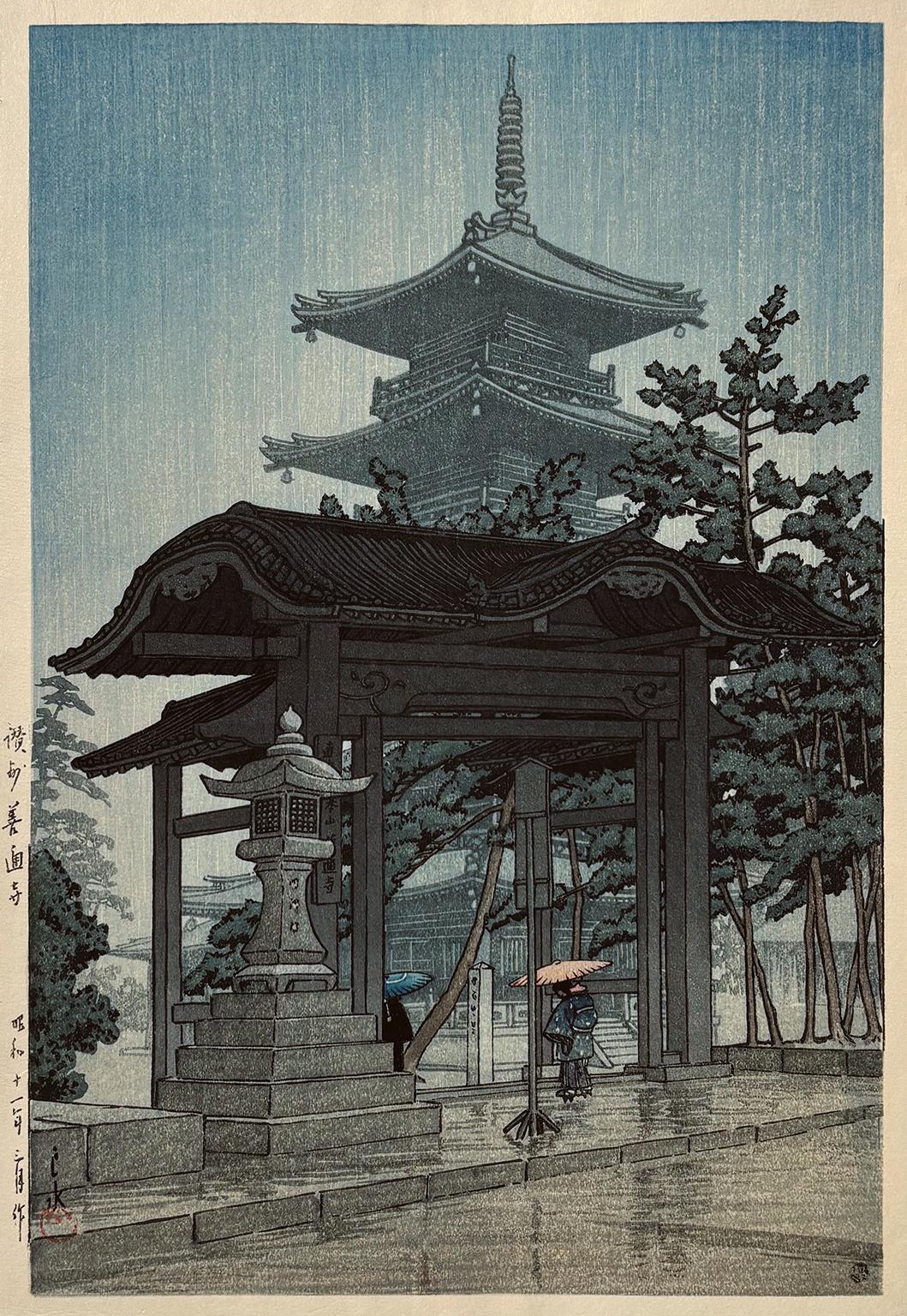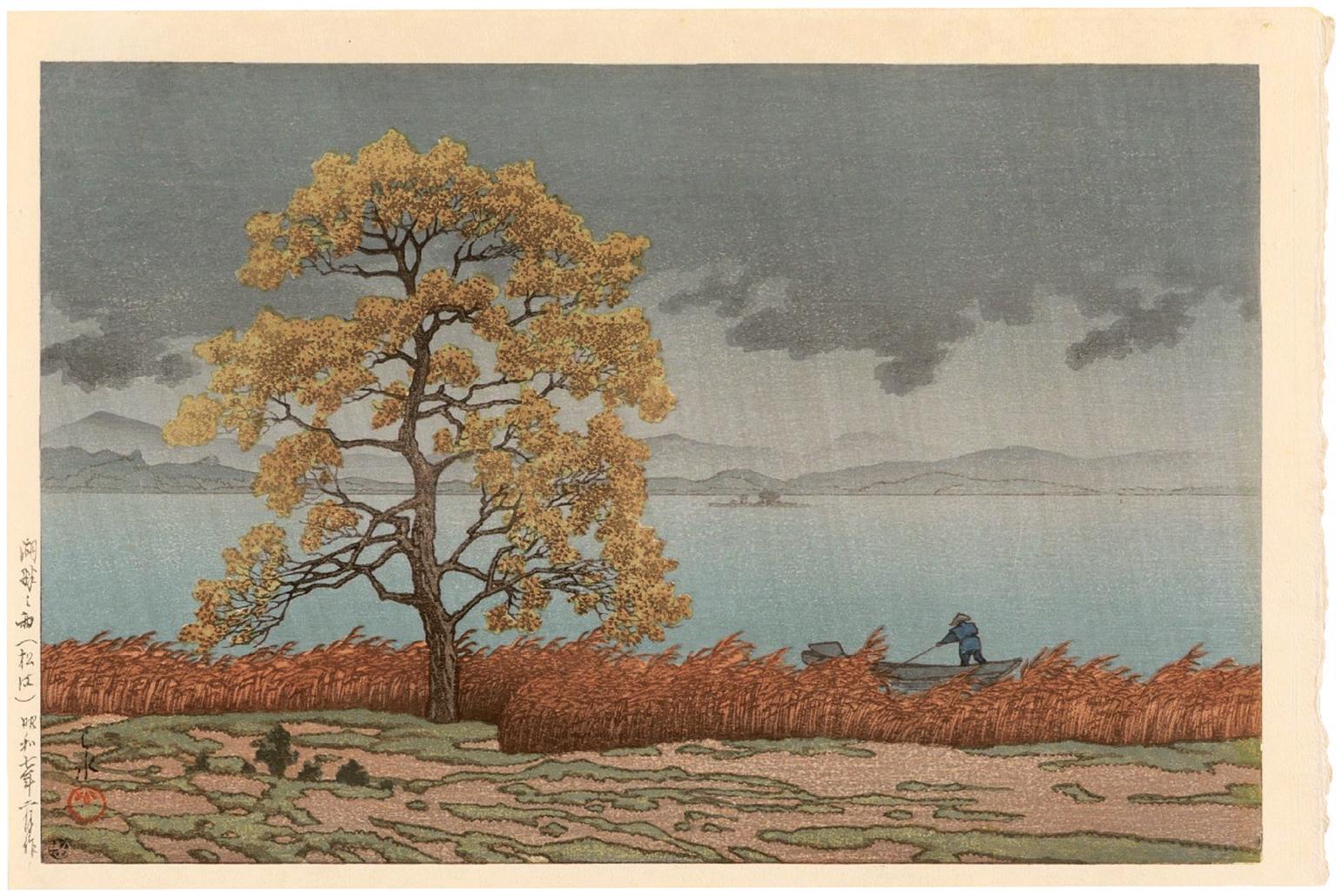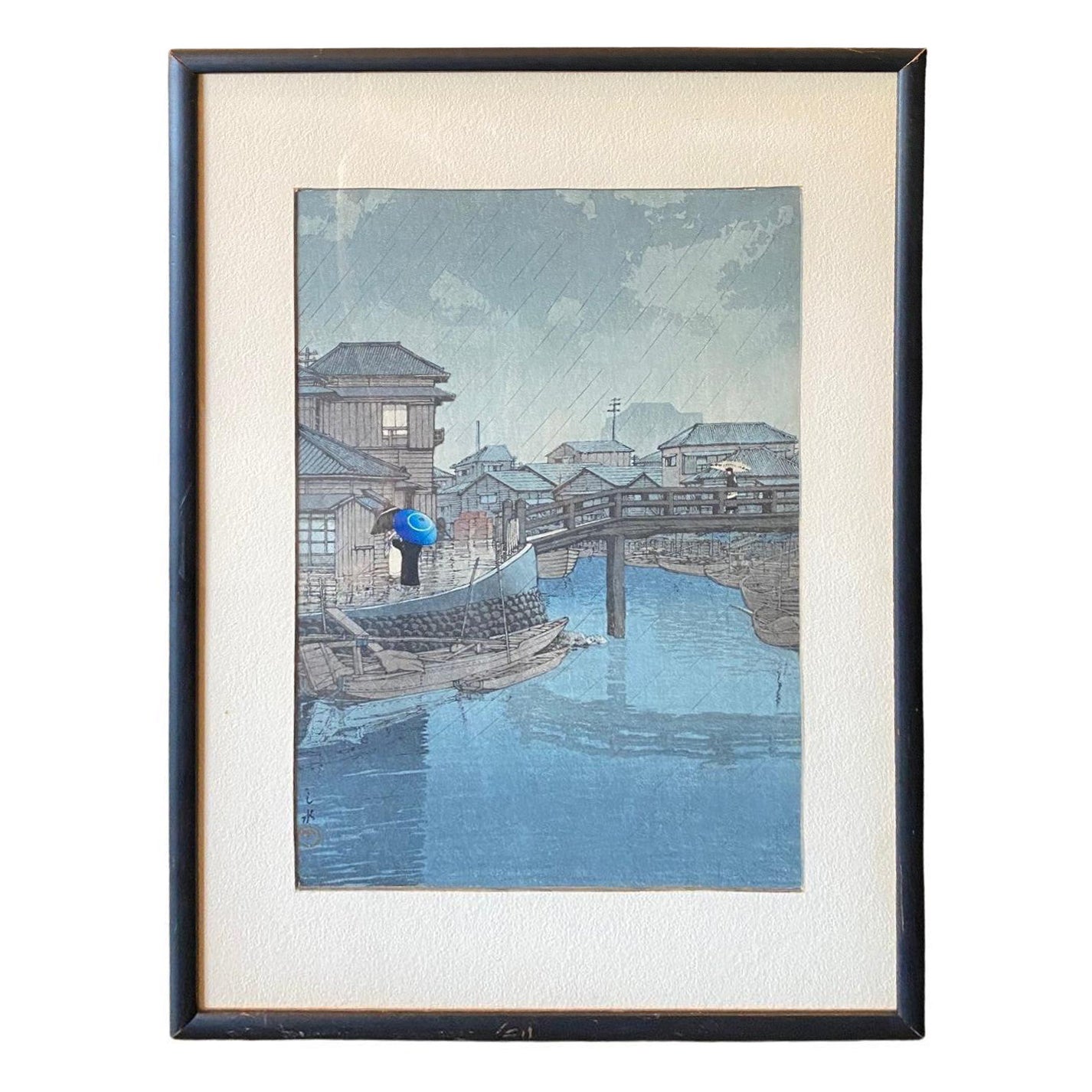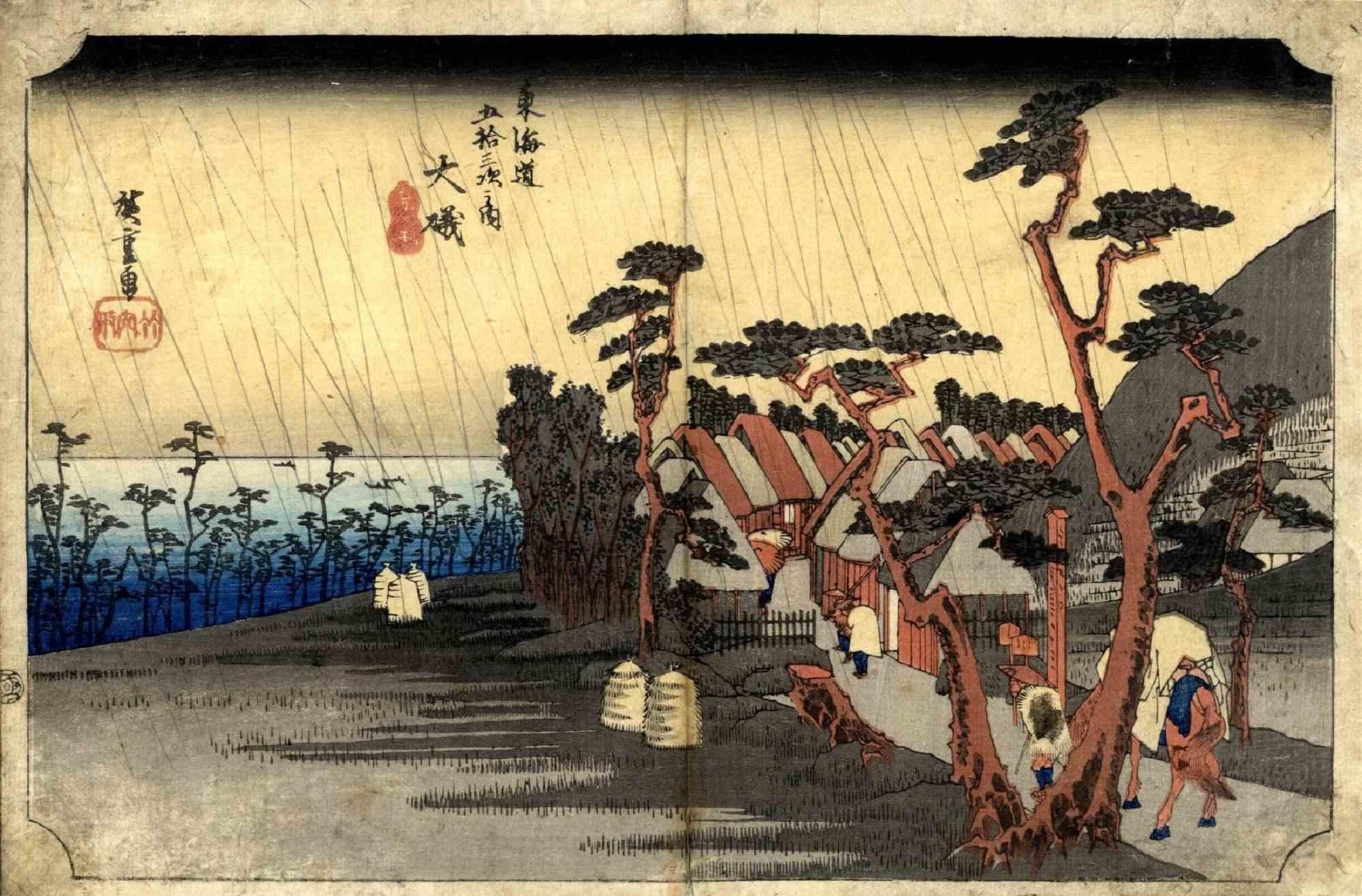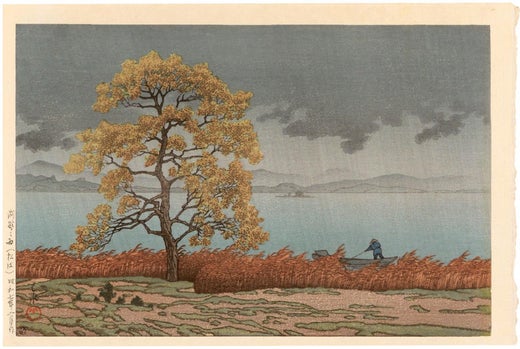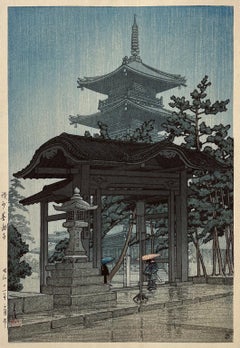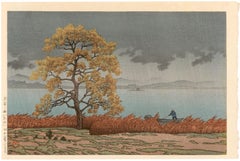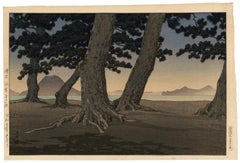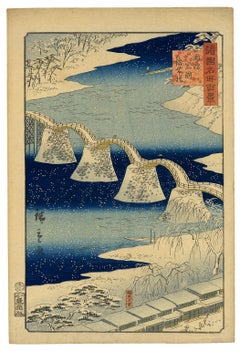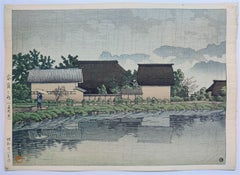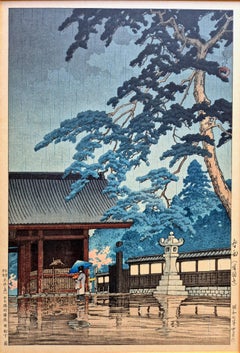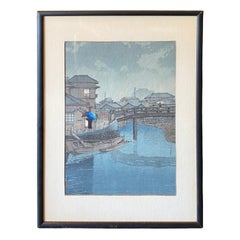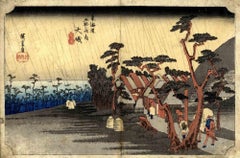Articoli simili a 'Rain at Shinagawa, Ryoshimachi' — Showa-era Woodblock Print
Vuoi altre immagini o video?
Richiedi altre immagini o video al venditore
1 di 3
Kawase Hasui'Rain at Shinagawa, Ryoshimachi' — Showa-era Woodblock Print1931
1931
1815,64 €
Informazioni sull’articolo
Kawase Hasui, 'Rain at Shinagawa, Ryoshimachi' from the series 'Selection of Views of the Tokaido', woodblock print, 1931. A very fine, atmospheric impression, with fresh colors; the full sheet, from a postwar edition, in excellent condition. Signed 'Hasui' with the artist’s red seal 'Kawase', lower left. Published by Watanabe Shozaburo with the Watanabe 6mm round seal lower left. Archivally sleeved, unmatted.
Image size 14 1/4 x 9 3/8 inches (362 x 238 mm); sheet size 15 1/2 x 10 3/8 inches (391 x 264 mm).
Impressions of this work are in the permanent collections of the Art Institute of Chicago, Fine Arts Museum of San Francisco, Achenbach Foundation; The National Museum of Modern Art, Tokyo.
ABOUT THE ARTIST
“I do not paint subjective impressions. My work is based on reality...I can not falsify...(but) I can simplify…I make mental impressions of the light and color at the time of sketching. While coloring the sketch, I am already imagining the effects in a woodblock print.” — Kawase Hasui
Kawase Hasui (1883–1957) is the most celebrated 20th-century Japanese print designer of the shin-hanga ('new prints') movement pioneered by the renowned publisher Watanabe Shozaburo. Hasui worked almost exclusively on landscape and townscape prints based on his sketches in Tokyo and during his travels in Japan. His subjects are not only 'meishō' (famous places) prints, which were typical of the earlier ukiyo-e masters such as Hiroshige and Hokusai, but also feature tranquil and picturesque scenes in obscure locations. Hasui considered himself a realist and employed his training in Western painting to create his lyrical renderings with naturalistic light, shade, and texture. Hasui was able to evoke the fleeting beauty of Japan during the interwar period as no printmaker of his time could.
Hasui's work enjoyed great popularity upon producing his first print in 1918. Watanabe recognized and cultivated the enormous potential of the American market, resulting in Hasui's prints achieving high prices at auctions in New York as early as the 1920s. After the Second World War, his prints became highly sought-after collectible works among the American occupying forces in Japan. Hasui designed more than 600 prints during the 40 years of his artistic career, and in 1956, he was named a 'Living National Treasure' of Japan.
Hasui’s woodblock prints are included in many important museum collections of Japanese prints worldwide, including the Art Institute of Chicago, British Museum, Brooklyn Museum, Clark Art Institute, Cooper Hewitt, Smithsonian Design Museum, Freer Gallery of Art, Harvard Art Museums, Indianapolis Museum of Art, The Israel Museum (Jerusalem), Japan Ukiyo-e Museum (Matsumoto, Japan), Los Angeles County Museum of Art, Metropolitan Museum of Art, Minneapolis Institute of Art, MOA Museum of Art (Japan), Museum of Fine Arts Boston, Nelson-Atkins Museum of Art, Portland Art Museum, Stanley Museum of Art, Toledo Museum of Art, Tokyo Museum Collection (Japan), University of Michigan Museum of Art, Walters Art Museum, Smart Museum of Art, and the Virginia Museum of Fine Arts.
- Creatore:Kawase Hasui (1883-1957, Giapponese)
- Anno di creazione:1931
- Dimensioni:Altezza: 36,2 cm (14,25 in)Larghezza: 23,83 cm (9,38 in)
- Tecnica:
- Movimento e stile:
- Periodo:
- Condizioni:
- Località della galleria:Myrtle Beach, SC
- Numero di riferimento:Venditore: 982031stDibs: LU532316458462
Kawase Hasui
Kawase Hasui (giapponese, 1883-1957) è stato un artista, uno dei più importanti e prolifici stampatori del Giappone moderno. Fu un disegnatore di spicco del movimento shin-hanga ("nuove stampe"), i cui artisti raffiguravano soggetti tradizionali con uno stile influenzato dall'arte occidentale. Come molte stampe ukiyo-e precedenti, le opere di Hasui erano generalmente paesaggi, ma mostravano effetti atmosferici e illuminazione naturale. Hasui ha disegnato circa 620 stampe nel corso di una carriera di quasi quarant'anni. Verso la fine della sua vita il governo lo ha riconosciuto come Tesoro Nazionale Vivente per il suo contributo alla cultura giapponese. Fin da giovane Hasui sognava una carriera artistica. Suo zio materno era Kanagaki Robun (1829-94), un autore e giornalista giapponese che ha prodotto la prima rivista manga. Da giovane Hasui frequentò la scuola del pittore Aoyagi Bokusen. An He fece schizzi dalla natura, copiò le stampe woodblock dei maestri e studiò la pittura a pennello con Araki Kanyu. I suoi genitori gli fecero assumere l'attività di famiglia di vendita all'ingrosso di corde e fili, ma il fallimento di quest'ultima all'età di 26 anni gli permise di dedicarsi all'arte. Si rivolse a Kiyokata Kaburagi perché gli insegnasse, ma Kaburagi lo incoraggiò a studiare pittura in stile occidentale, cosa che fece con Okada Saburōsuke per due anni. Due anni dopo fece nuovamente domanda come studente a Kaburagi, che questa volta lo accettò. Kiyokata gli ha dato il nome Hasui, che può essere tradotto come "acqua che sgorga da una sorgente" e deriva dalla sua scuola elementare combinata con un ideogramma del suo nome di famiglia. Kawase studiò ukiyo-e e pittura in stile giapponese presso lo studio di Kiyokata Kaburagi. An He si concentrò principalmente sulla realizzazione di acquerelli di attori, vita quotidiana e paesaggi, molti dei quali furono pubblicati come illustrazioni in libri e riviste negli ultimi anni del periodo Meiji e all'inizio del periodo Taishō. Kawase lavorava quasi esclusivamente a stampe di paesaggi e città basate su schizzi e acquerelli realizzati a Tokyo e durante i viaggi in Giappone. Tuttavia, le sue stampe non sono semplici meishō (luoghi famosi), tipiche dei precedenti maestri dell'ukiyo-e come Hiroshige e Katsushika Hokusai (1760-1849). Le stampe di Kawase raffigurano luoghi tranquilli e oscuri nel Giappone in via di urbanizzazione. Le opere di Kawase Hasui sono attualmente conservate in diversi musei di tutto il mondo, tra cui il British Museum, il Toledo Museum of Art, il Brooklyn Museum, l'Indianapolis Museum of Art, il Museum of Fine Arts di Boston, il Metropolitan Museum of Art, il Portland Art Museum, il Los Angeles County Museum of Art, il Museo d'Arte dell'Università del Michigan, il Minneapolis Institute of Art, lo Stanley Museum of Art, il Walters Art Museum, il Clark Art Institute, lo Smart Museum of Art, il Nelson-Atkins Museum of Art e il Virginia Museum of Fine Arts.
Informazioni sul venditore
5,0
Venditore riconosciuto
Questi venditori prestigiosi sono leader del settore e rappresentano il massimo in termini di qualità e design.
Venditore Platino
Venditori Premium con valutazione 4.7+ e tempi di risposta entro 24 ore
Fondazione nel 1995
Venditore 1stDibs dal 2016
321 vendite su 1stDibs
Tempo di risposta standard: 1 ora
Associazioni
International Fine Print Dealers Association
- SpedizioneRecupero del preventivo…Spedizione da: Myrtle Beach, SC
- Politica di reso
Alcune parti di questa pagina sono state tradotte automaticamente. 1stDibs non può garantire che le traduzioni siano corrette. L’inglese è la lingua predefinita del sito.
Garanzia di autenticità
Nell’improbabile caso in cui si verifichi un problema con l’autenticità di un articolo, contattaci entro un anno per ottenere un rimborso completo. DettagliGaranzia di rimborso
Se il tuo articolo non corrisponde alla descrizione, è danneggiato durante il trasporto o non arriva, contattaci entro 7 giorni per un rimborso completo. DettagliAnnullamento entro 24 ore
Hai un periodo di tolleranza di 24 ore per annullare il tuo acquisto, senza necessità di fornire spiegazioni.Venditori professionali selezionati
I nostri venditori di livello internazionale devono aderire a rigorosi standard di servizio e qualità, garantendo l’integrità delle inserzioni.Garanzia miglior prezzo
Se scopri che un venditore ha pubblicato altrove lo stesso articolo a un prezzo più basso, applicheremo lo stesso prezzo.Consegna globale affidabile
La nostra rete di vettori leader del settore offre opzioni di spedizione specializzate in tutto il mondo, inclusa la consegna personalizzata.Altro da questo venditore
Mostra tuttoIl tempio di Zentsuji sotto la pioggia - dalla serie Collection'S Views of Japan II
Di Kawase Hasui
Kawase Hasui, "Il tempio di Zentsuji sotto la pioggia" dalla serie "Collected Views of Japan II", stampa woodblock a colori, 1937. Firmato Hasui in inchiostro nero, con il sigillo r...
Categoria
Anni 1930, Showa, Stampe (paesaggio)
Materiali
Xilografia
Doccia in riva al lago, Matsue" - Stampa woodblock a colori dell'epoca dello spettacolo
Di Kawase Hasui
Kawase Hasui, "Chihan no Ame, Matsue" (Doccia sul lago, Matsue), stampa woodblock a colori, 1932. Un'impressione fine e suggestiva, con colori freschi; il foglio completo, da un'ediz...
Categoria
Anni 1930, Showa, Stampe figurative
Materiali
Xilografia
La spiaggia di Kaiganji, nella provincia di Sanuki - Impressione a vita
Di Kawase Hasui
La spiaggia di Kaiganji nella provincia di Sanuki (Sanuki Kaiganji no hama), dalla serie Collected Views of Japan II, Kansai Edition (Nihon fûkei shû II Kansai hen), stampa su legno,...
Categoria
Anni 1930, Showa, Stampe (paesaggio)
Materiali
Xilografia
Ponte Kintai a Iwakuni nella provincia di Suo (Suo iwakuni kintai-bashi), 1859
Di Hiroshige II
Utagawa Hiroshige II (1829-1869), "Ponte di Kintai a Iwakuni nella provincia di Suo" (Suo iwakuni kintai-bashi), dalla serie "Cento vedute di luoghi famosi nelle province" (Shokoku m...
Categoria
Anni 1850, Edo, Stampe (paesaggio)
Materiali
Xilografia
Interno del Tempio di Kannon ad Asakusa" - Punto di riferimento di Tokyo, prima edizione
NARAZAKI EISHO (1864-1936), "Asakusa Kannon-do no naido" (Interno del tempio di Kannon ad Asakusa), stampa xilografica a colori, 1932. Firmato Eisho in basso a destra, con il sigillo...
Categoria
Anni 1930, Stampe (interni)
Materiali
Xilografia
Tokaido - Il monte Fuji che sorge - Stampa su legno della metà del XIX secolo
Di Utagawa Kunisada (Toyokuni III)
Utagawa Kunisada (Tokoyuni III), 'Tokaido', xilografia a colori, 1863. Firmato nel cartiglio, in basso a destra. Ottima impressione, con colori ricchi e freschi e una marcata venatur...
Categoria
Anni 1860, Edo, Stampe figurative
Materiali
Xilografia
Ti potrebbe interessare anche
Kawase Hasui -- Pioggia a Yasuniwa (Nagano)
Di Kawase Hasui
Kawase Hasui
Pioggia a Yasuniwa (Nagano), 1946
xilografia a colori
Firmato sul blocco, sigillato, intitolato e datato ad inchiostro
Editore: Shozaburo Watanabe, con il suo sigillo da...
Categoria
Anni 1940, Stampe (paesaggio)
Materiali
Xilografia
2739 € Prezzo promozionale
20% in meno
Kawase Hasui -- Pioggia di primavera al Tempio Gokoku
Di Kawase Hasui
Kawase Hasui
Pioggia di primavera al Tempio Gokoku-ji, 1932
Stampa woodblock
Prima pubblicazione: 1932
Dimensioni del foglio: 39 × 26 cm
Data di questa edizione: 1932, 1a edizione...
Categoria
Anni 1930, Stampe e riproduzioni
Materiali
Xilografia
7470 € Prezzo promozionale
20% in meno
Kawase Hasui Stampa su lastra di legno giapponese Shinagawa Dalla serie Views of the Tokaido
Di Kawase Hasui 1
Una bellissima stampa su xilografia dai colori vivaci realizzata dal Famed artista giapponese e maestro di stampa Shin-Hanga Kawase Hasui. Questa stampa, intitolata "Shinagawa", fa p...
Categoria
Vintage, Anni 1930, Giapponese, Showa, Stampe
Materiali
Carta
Stazione di Oiso sotto la pioggia - xilografia di Utagawa Hiroshige -1833
Di Utagawa Hiroshige
La stazione di Oiso sotto la pioggia è un'opera d'arte moderna originale realizzata da Utagawa Hiroshige (1797 - 12 ottobre 1858) nel 1833-1834.
Stampa xilografica originale Oban yo...
Categoria
Anni 1830, Moderno, Stampe figurative
Materiali
Xilografia
1388 € Prezzo promozionale
24% in meno
Edizione anteguerra Stampa su legno giapponese Tempio Honmon-ji Kawase Hasui
Di Kawase Hasui 1
Una stampa prebellica di Kawase Hasui (1883-1957) raffigura l'ingresso del famoso tempio di Tokyo Ikegami Honmon-ji in una giornata di neve. Creata nel 1931, l'immagine cattura l'atm...
Categoria
Vintage, Anni 1940, Giapponese, Moderno, Stampe
Materiali
Carta
Santuario di Umewaka sotto la pioggia
Di Kobayashi Kiyochika
Santuario di Umewaka, da una serie di stampe senza titolo che raffigurano Tokyo. Una donna tiene l'ombrello contro la pioggia e un uomo aspetta il temporale accanto al suo jinriksha ...
Categoria
Anni 1870, Edo, Stampe (paesaggio)
Materiali
Carta fatta a mano, Carta di gelso, Xilografia
